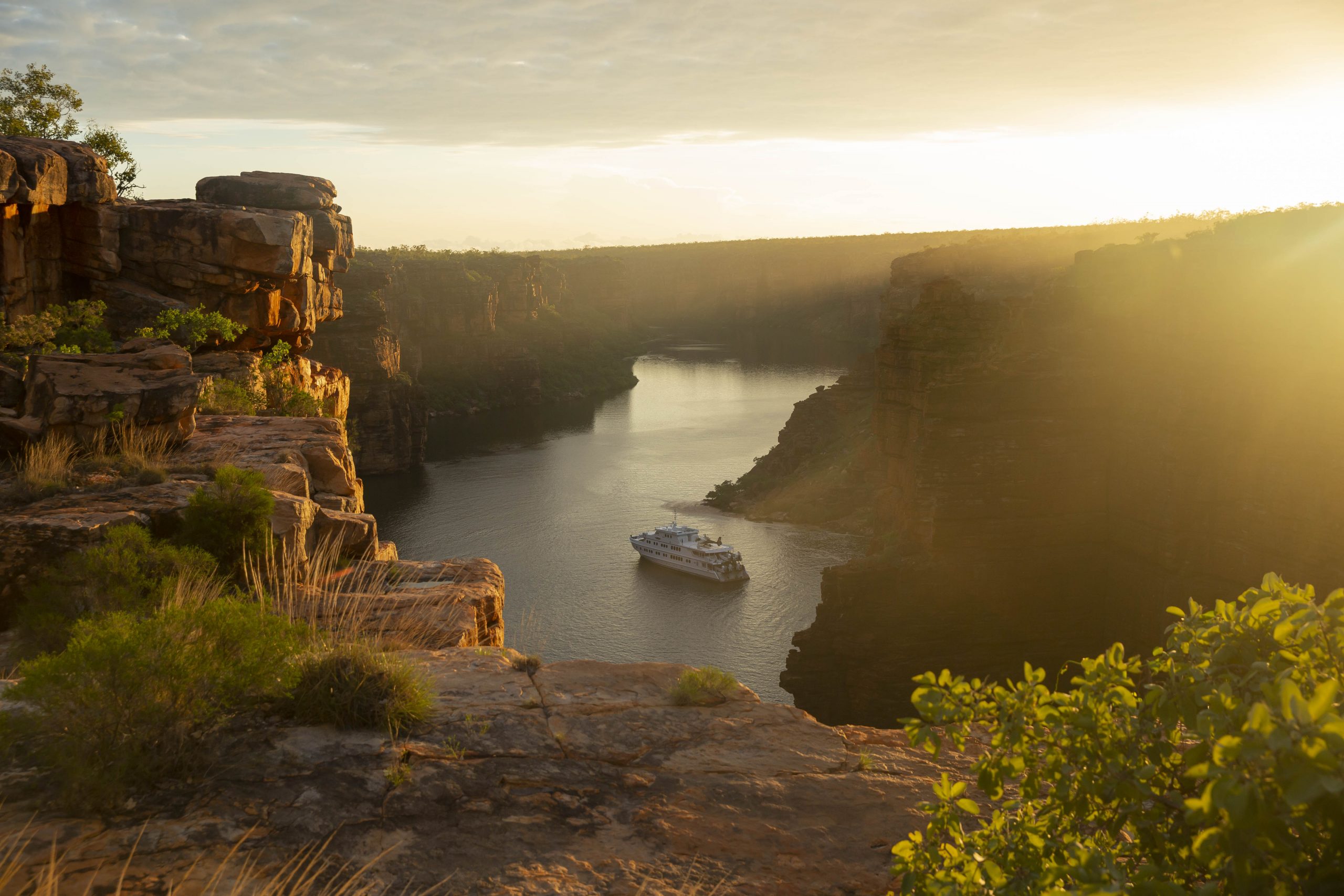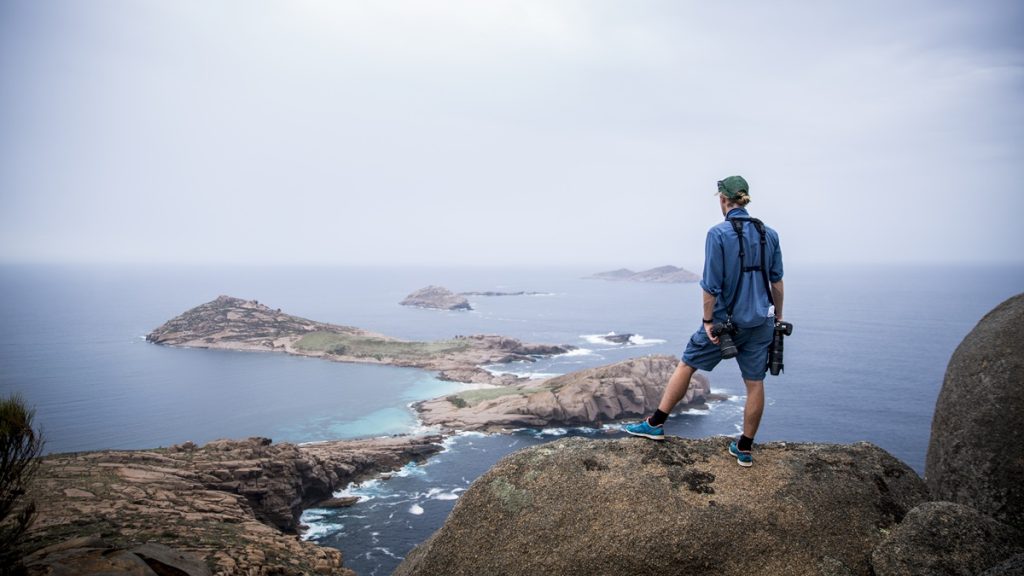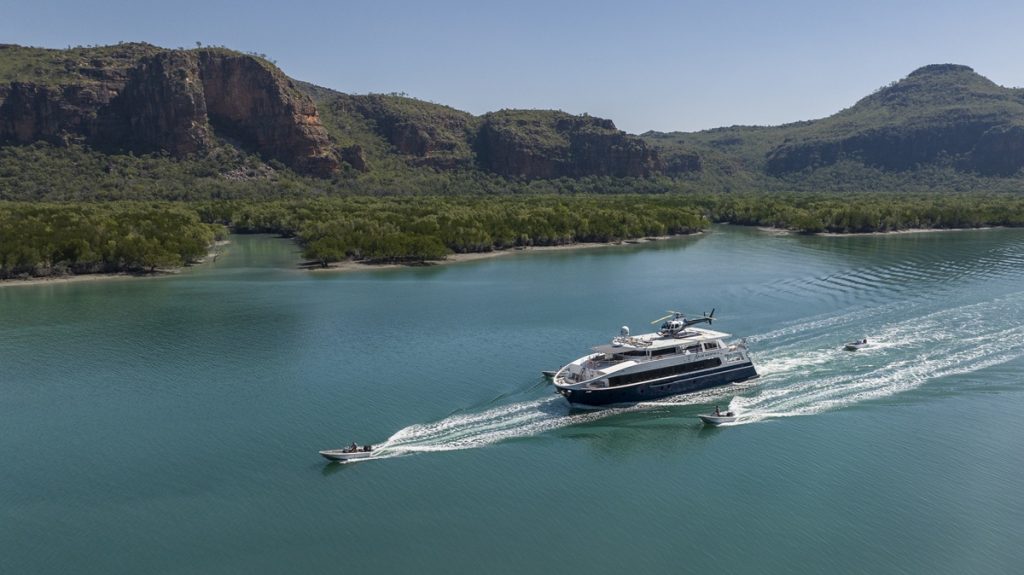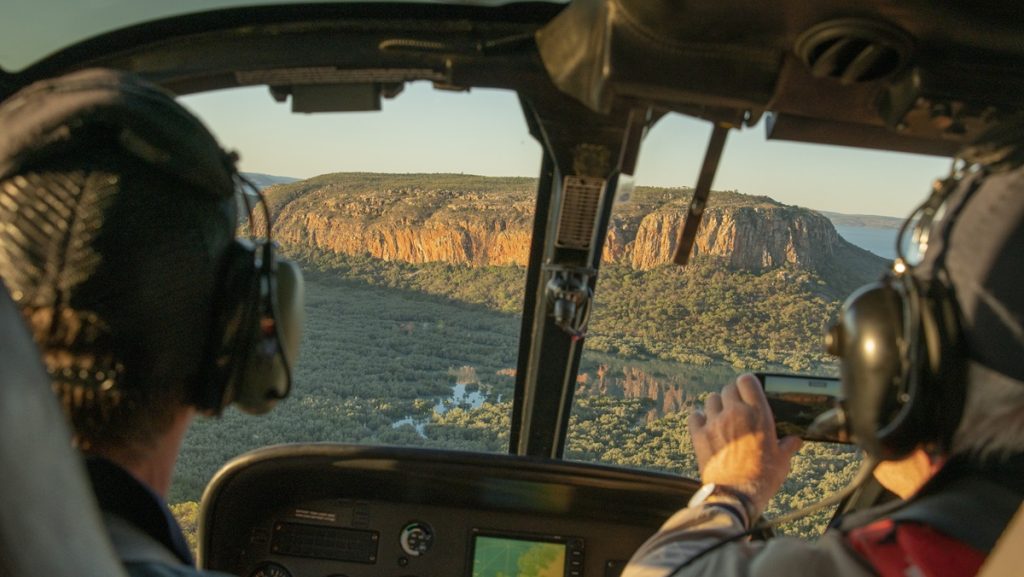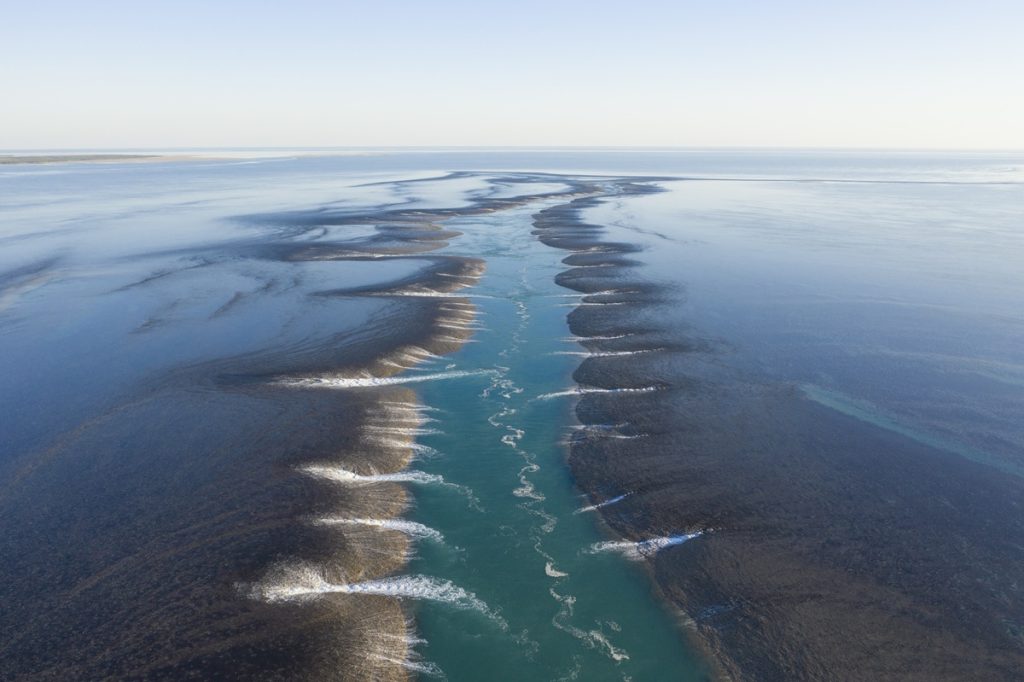If you’ve ever thought about visiting the Kimberley region, you may be feeling a little overwhelmed. A region teeming with natural wonders, it can be hard to decide what to see in the Kimberley.
That’s why we’ve put together this list. From the awe-inspiring Horizontal Falls to the majestic Bungle Bungles, the serene Eagle Falls to the mystical Buccaneer Archipelago, each spot tells a story of timeless beauty and adventure.
This list is by no means exhaustive, but it’s a great starting point! Read on to find out what you need to see in the Kimberley.
Horizontal Falls
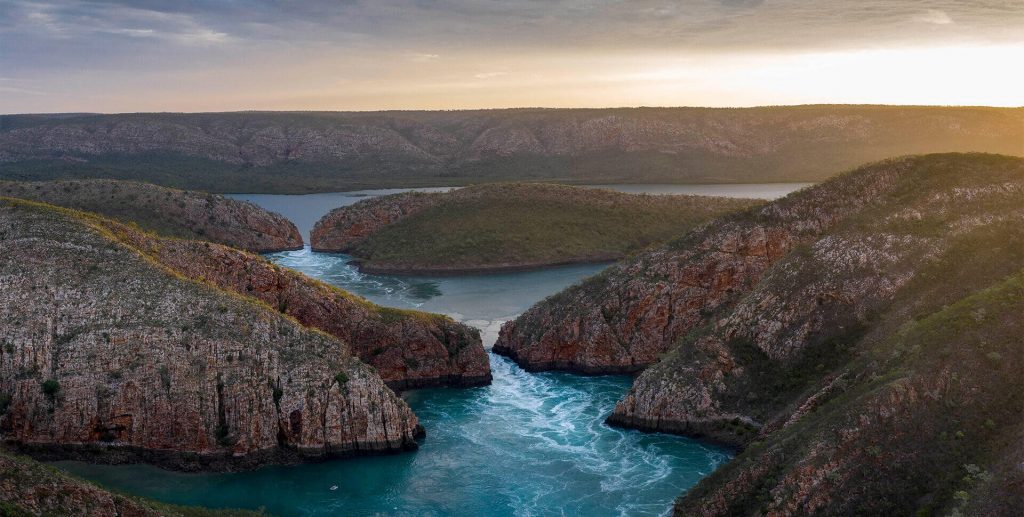
Described by Sir David Attenborough as one of the greatest natural wonders of the world (he wasn’t wrong), the Horizontal Falls (known as the ‘Horries’ by locals) are an extraordinary natural phenomenon within the Talbot Bay area of the McLarty range.
These ‘falls’ are not typical waterfalls; they are a fast-moving tidal flow through two narrow, closely aligned gorges. The intense tidal currents in this region can reach up to 11 metres, among the highest in the world, causing the water to rush through the gorges at speed. This creates a horizontal ‘waterfall’ effect, a spectacle that changes direction with the ebb and flow of the tides.
The best way to experience the Horizontal Falls is by boat or seaplane. Many tours, including the TRUE NORTH, offer thrilling boat rides through the falls, allowing you to experience the power of the tidal currents up close. For a more panoramic view, scenic flights provide a bird’s-eye perspective of this natural wonder, showcasing the stunning contrast between the deep blue waters and the rugged red cliffs of the Kimberley region.
Bungle Bungle Range
Famous for its striking beehive-shaped towers, the Bungle Bungles are a geological wonder. Located in the Purnululu National Park in Western Australia, it’s part of the UNESCO World Heritage-listed park and is a spectacular example of the beauty and uniqueness of Australia’s natural landscape.
Formed over 350 million years ago, these sandstone formations have undergone a remarkable process of erosion and weathering, resulting in their striking appearance. Some of the structures reach up to 300 metres in height!
You might notice a fascinating pattern of orange and black stripes on them; the orange bands are created by iron and manganese mineral deposits, while the black bands get their colour from cyanobacteria (blue-green algae) that grow on the layers where moisture accumulates.
The Bungle Bungles are not only a geological marvel but also a culturally significant site for the Indigenous custodians, who have a deep spiritual connection to this land. The area is imbued with cultural stories and traditions, adding an enriching layer to the visitor experience.
Eagle Falls
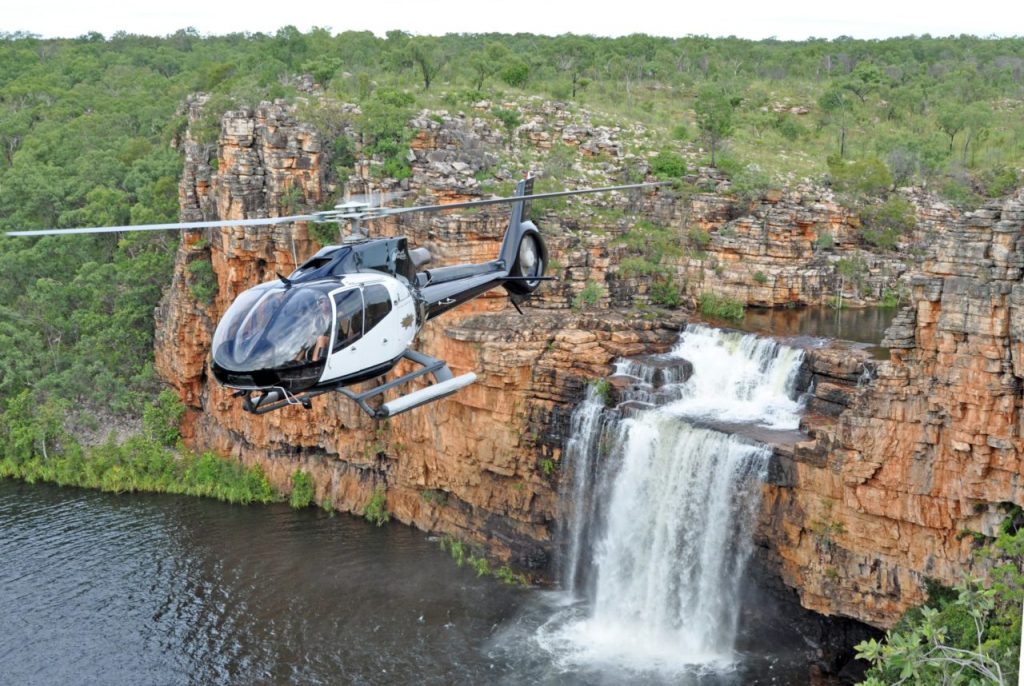
Nestled within the rugged and remote landscapes of the Kimberley region, Eagle Falls is a hidden gem. These falls are fed by the King Edward River, and offer beautiful cascades and a deep, clear pool against a backdrop of rugged cliffs and lush vegetation.
Swim, bushwalk around the area, or even go fishing in the King Edward River for its abundance of barramundi. The isolation of Eagle Falls contributes to its charm, offering a sense of seclusion and peace that is increasingly rare in today’s world.
Buccaneer Archipelago
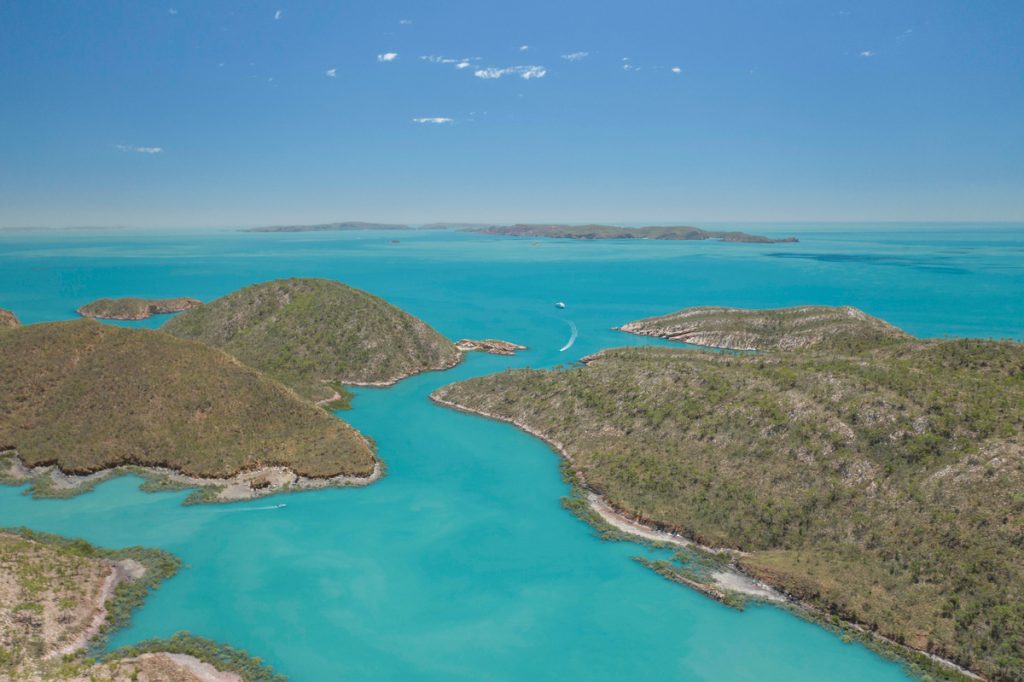
The Buccaneer Archipelago is a breathtaking cluster of around 1000 small, rugged islands off the Kimberley coast. This largely untouched archipelago is famed for its incredible natural beauty, rich cultural history, and unique marine environments.
Formed over billions of years, the islands of the Buccaneer Archipelago are characterised by their rugged, rocky terrain, stunning red cliffs, and secluded white sandy beaches. The surrounding waters are teeming with marine life, making it an ideal spot for fishing, snorkelling, and diving. Home to a diverse array of marine species, including dugongs, turtles, and fish, the area also boasts some of the world’s most extensive and untouched coral reef systems.
Culturally, the Buccaneer Archipelago holds significant importance for the Indigenous people of the Kimberley region. The islands and surrounding sea country have been home to the Indigenous Bardi Jawi people for thousands of years and are rich in Aboriginal history and tradition. The islands are dotted with ancient rock art sites, providing a window into the lives and stories of the traditional custodians of the land.
Cape Leveque
Known for its vibrant contrasts of red cliffs, pristine white beaches, and the crystal-clear blue waters of the Indian Ocean, Cape Leveque is a serene and idyllic escape for nature lovers and those seeking tranquillity. Located at the northern tip of the Dampier Peninsula, Cape Leveque has a dramatic coastline where the deep red of the cliffs meets the white sandy shores.
Lake Argyle
Nestled in the rugged landscapes of the Kimberley region, Lake Argyle holds the distinction of being Australia’s second-largest artificial lake. Created by the damming of the Ord River in the 1970s, this vast expanse of water has since become a pivotal ecological and recreational hub.
Spanning over 1000 square kilometres, Lake Argyle’s size can swell up to five times during the wet season, making it a phenomenal sight in its own right. The lake’s vast surface is dotted with over 70 islands, offering a stunning visual spectacle that blends water and wilderness.
The lake is a paradise for wildlife enthusiasts. It’s home to an incredible array of fauna, particularly when it comes to birds. With over 240 bird species recorded in the area, including rare and migratory birds, Lake Argyle is a premier destination for birdwatchers. The tranquil waters and abundant food sources also attract a variety of aquatic animals. Freshwater crocodiles are commonly sighted basking on the banks or swimming in the waters.
Fishing enthusiasts will find Lake Argyle an ideal spot, as it’s teeming with a variety of fish species, including the iconic Barramundi. The vastness of the lake allows for peaceful and successful fishing expeditions, offering a perfect blend of relaxation and thrill.
Gibb River Road
A legendary track cutting through the heart of the Kimberley region, the Gibb River Road is an iconic route for adventurers and nature lovers. Stretching approximately 660 kilometres, this former cattle route runs from Derby to the Kununurra and Wyndham junction, offering a quintessential Australian outback experience.
If you travel for any stretch along Gibb River Road, you’ll encounter a range of breathtaking natural attractions, from the Kimberley’s most stunning and secluded gorges to cascading waterfalls and clear pools.
And it’s not just about the natural wonders; it’s also a corridor through time. The area is rich in Indigenous culture, which you’ll see in the numerous Aboriginal rock art sites along the route. These sites, like at Galvans Gorge and Manning Gorge, offer a glimpse into the ancient stories and art of the region’s traditional owners.
For river enthusiasts, the Pentecost River crossing is a notable feature of the journey, providing a challenging and iconic river crossing experience. The river’s backdrop against the Cockburn Range is a photographer’s dream, especially at sunrise or sunset.
Mitchell Falls

Located on the remote Mitchell Plateau, the Mitchell Falls stands as one of the area’s most breathtaking and iconic landmarks. They are a stunning cascade of water over four major tiers, with several smaller falls between them. The total drop is around 80 metres, making it a powerful sight that is only made more incredible by the sound of the thundering water.
The area around Mitchell Falls is also rich in Indigenous culture. The Wunambal Gaambera people are the traditional custodians of the land and have a deep spiritual connection to this place. The numerous rock art sites in the area are a testament to the rich cultural history of the Indigenous people in this region.
Visiting Mitchell Falls is not only about witnessing the falls themselves but also about experiencing the isolation and untouched beauty of the Mitchell Plateau. This area is one of the most remote and unspoiled regions in Australia, offering a true wilderness experience.
King George Falls
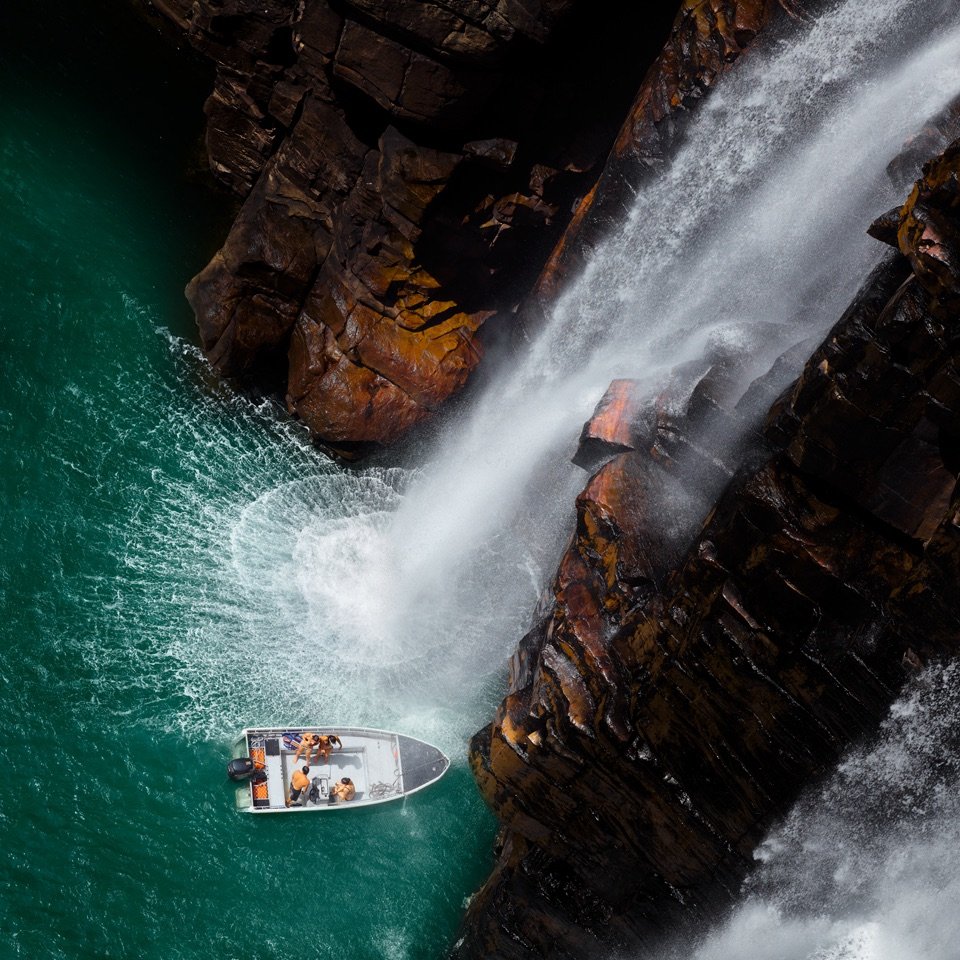
The King George Falls stands as one of the most magnificent waterfalls in the area. Known for its dramatic dual drop, King George Falls cascades over 100 metres, making it one of the tallest waterfalls in Western Australia.
The falls are fed by the King George River, which meanders through ancient sandstone cliffs before plunging spectacularly over a sheer cliff into a deep gorge below.
Visiting King George Falls is more than just witnessing a natural attraction; it’s an immersive experience in one of Australia’s most remote and unspoiled regions. The journey to the falls, whether by boat or air, and the stunning scenery that surrounds them, make a trip to King George Falls a memorable adventure and a highlight of any Kimberley itinerary.
Windjana Gorge and Tunnel Creek National Parks
Located in the heart of the Kimberley region, Windjana Gorge and Tunnel Creek National Parks are remarkable havens known for their striking geological formations, rich cultural history, and diverse wildlife.
Windjana Gorge National Park is known for – you guessed it – its majestic gorge, carved by the Lennard River through an ancient Devonian reef system over millions of years. The towering limestone walls of Windjana Gorge, rising up to 100 metres in height, stretches for about 3.5 kilometres, with the Lennard River flowing through it during the wet season and leaving behind serene pools in the dry season. These pools are home to freshwater crocodiles, providing a unique opportunity to safely observe them in their natural habitat.
Tunnel Creek National Park, just a short drive from Windjana Gorge, offers something very different. Best known for its 750-metre-long natural tunnel carved through the Napier Range, it’s the oldest cave system in Western Australia. Here, you’re able to walk through the tunnel, wading through freshwater pools and marvelling at the stalactites and stalagmites, while learning about the Aboriginal history of the area.
Hunter River
The Hunter River is a majestic, unspoiled natural wonder. This remote river is renowned for its dramatic landscapes, including towering red cliffs, dense mangrove forests, and a network of rivers and estuaries that create a haven for wildlife. Home to saltwater crocodiles, mud crabs, barramundi, and a myriad of bird and fish species, there is never a dull moment.
Montgomery Reef
The Montgomery Reef is one of the region’s most unique and dynamic marine environments. This vast and remote reef system, covering approximately 300 square kilometres, is known for the extraordinary phenomenon that occurs during the falling tide.
As the tide recedes, Montgomery Reef seemingly rises from the ocean, revealing a vast, exposed reef system teeming with life. This dramatic transformation occurs daily, creating cascading waterfalls as the sea drains off the reef, and vast lagoons and channels are temporarily revealed. It’s a spectacular natural event that showcases the powerful tidal movements of the Kimberley coast.
Cathedral Gorge
Located in the heart of the Bungle Bungle Range, Cathedral Gorge is a natural amphitheatre renowned for its remarkable acoustics and striking rock formations. The gorge has been sculpted over millions of years by water erosion, and its smooth, curved surfaces bear testament to the ancient forces of nature at work.
As you enter, the most striking feature is the towering walls that rise dramatically on all sides, converging into a spacious, natural amphitheatre. One of the most enchanting experiences when visiting Cathedral Gorge is the play of light and shadow as the sun moves across the sky. The changing light conditions throughout the day dramatically alter the appearance of the gorge, and it’s pretty spectacular to see!
The Drysdale
Nestled in the remote, rugged landscapes of the Kimberley region sits the Drysdale River, one of the area’s most pristine and untouched natural treasures. As one of the longest and most significant rivers in the Kimberley, the Drysdale offers a unique insight into the region’s diverse ecosystems, rich history, and stunning beauty.
The river banks and surrounding habitats are teeming with an array of bird species, making it a bird-watchers paradise. The waterways are also home to freshwater crocodiles, turtles, and a variety of fish, providing ample opportunity for wildlife spotting.
This is just the beginning
We could talk on and on about what to see in the Kimberley and never run out of things to talk about. And really, the above list is only just a snapshot of the spectacular things you can see when you embark on an adventure on board the TRUE NORTH.
Our selection of Kimberley cruises will take you on a journey through the untouched Kimberley wilderness, away from the hustle and bustle of regular tours, so you can truly appreciate it in all its natural glory. Explore our small ship cruise itineraries today, and book your spot for the trip of a lifetime!
